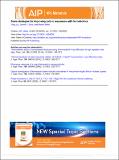Some strategies for improving caloric responses with ferroelectrics
Date
17/06/2016Metadata
Show full item recordAbstract
Many important breakthroughs and significant engineering developments have been achieved during the past two decades in the field of caloric materials. In this review, we address ferroelectrics emerging as ideal materials which permit both giant elastocaloric and/or electrocaloric responses near room temperature. We summarize recent strategies for improving caloric responses using geometrical optimization, maximizing the number of coexisting phases, combining positive and negative caloric responses, introducing extra degree of freedom like mechanical stress/pressure, and multicaloric effect driven by either single stimulus or multiple stimuli. This review highlights the promising perspective of ferroelectrics for developing next-generation solid-state refrigeration.
Citation
Liu , Y , Scott , J F & Dkhil , B 2016 , ' Some strategies for improving caloric responses with ferroelectrics ' , APL Materials , vol. 4 , no. 6 , 064109 . https://doi.org/10.1063/1.4954056
Publication
APL Materials
Status
Peer reviewed
ISSN
2166-532XType
Journal article
Description
Y.L. and B.D. acknowledge the China Scholarship Council (CSC) for funding Y.L.’s stay in France and a public grant overseen by the French National Research Agency (ANR) as part of the “Investissements d’Avenir” program (Reference No. ANR-10-LABX-0035, Labex NanoSaclay).Collections
Items in the St Andrews Research Repository are protected by copyright, with all rights reserved, unless otherwise indicated.

